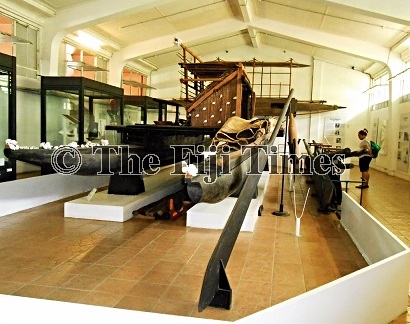Today, I am feeling nostalgic under the COVID-19 pandemic about my helplessness to celebrate International Museum Day (May 18 2020) in comparison to earlier years.
Last year, I got a golden opportunity to visit the National Museum of Australia, Canberra; Louvre Museum, Paris and Auckland War Memorial Museum, Auckland, but this year I was restricted due to pandemic effect.
The valuable contribution of a museum can not be underestimated as they have conserved past artefacts, protected the historical records, preserve and promote cultural heritage, display numerous galleries, a storehouse of artefacts, sculpture, numismatics, technological transaction and much more.
They act as a window into the past for learning diverse cultural heritage, and they act as if the custodian of our past and display authentic records.
Firstly, the definition of museum is essential as it is defined as “a non-profit making, permanent institution in the service of society and of its development, and open to the public, which acquires, conserves, researches, communicates and exhibits, for study, education, and enjoyment, material evidence of people and their environment” by International Council of Museums (ICOM) (2010).
This article enlightens the significance of International Museum Day, the contribution of Fiji’s Museum, and its possible role to foster tourism.
International Museum Day
2020 International Museum Day theme is “Museum for Equality: Diversity and Inclusion” in order to “celebrate the diversity of perspectives that make up the communities and personnel of museums, and champion tools for identifying and overcoming bias in what they display and the stories they tell … these disparities can relate to many topics, including ethnicity, gender, sexual orientation and identity, socioeconomic background, education level, physical ability, political affiliation and religious beliefs”.
The museum becomes vital to enlighten the past across time and space in contemporary times. Children visiting the museum get the dynamic opportunity to learn and connect to the past.
Artefacts of diverse generations displaying diverse rich cultures make museums unique and deserve a day to celebrate.
Historical heritage
People of all ages and background can explore these spaces to enhance one’s knowledge about different cultures.
This is displayed by Fiji Museum by displaying various galleries, such as maritime, history, masi, girmit and natural history.
Fiji’s maritime gallery exhibits knowledge on canoes, Ratu Finau Tui Nayau, bilibili, fishing, western awareness 1643-1799, sandalwood trade 1800-1820, foreign beachcombers 1800-1860, Beche-de-mer and the whalers.
South Pacific and Fiji’s human history is displayed by the things the human left behind in Fiji’s history gallery, as it display artefacts of Lapita, post-lapita pottery, trade between Fiji, Samoa and Tonga, personal adornment, old religion, cannibalism, Christianity, weapons, early experiments in government, the kingdom of Fiji 1871-1874; Colo and Seaqaqa wars; early European settlers; Rotuman, iKiribati, Chinese communities; Solomon labour trade (Blackbirding); stones, Fijian leaders and others.
The masi gallery specialises in displaying production, masi and fashion whereas the natural gallery displays amazing variety of plants, animals and shells.
The girmit gallery displays the journey of Indians labourers coming to Fiji between 1879-1916 under indenture system, their labour, settlement, music and dance, Indian art and jewellery; religions and Hindu weddings.
Fiji’s Museum’s mission is to inspire and promote respect for all the diverse cultures of Fiji with a vision to become a world-class museum so developed with the objective to “undertake more marketing, effective research, documentation, and presentation of historical artefacts, and the development of activities aimed at stimulating interest in culture and the arts”.
Fiji is fortunate compared with other small Pacific Islands to have a museum that enhances knowledge and foster tourism.
Museum and tourism
Tania Steyn argues that “all tourism activities contain some element of culture, ranging from visits to specific cultural sites such as museums, art galleries, or cathedrals, to experiencing the “atmosphere” of the city nightlife” (cited in Perera, 2013).
Kamani Perera further cites Nuryanti (1996) stating that in order to be successful in a tourism context, “heritage and history require more than preservation: its significance (should be) conveyed to the visitor, leading to enriched understanding in the context of the present”.
Thus, museums have become highly significant in connection with enhancing tourism. As many tourism destination planners use museums as attractions in different destination promotional plans (Tuffs & Milne, 1999). People of all ages are attracted to explore the historical knowledge and artifacts of different cultures.
National Museum of Australia in Canberra and Auckland War Memorial Museum in New Zealand has not just become the centre of knowledge but a renowed tourist attraction. Other Pacific nations may take them as an example to use these treasure houses as a tourist attraction to get a wider audience, display their cultural heritage and generate revenue.
Although museums are facing tough competition with amusement and theme parks; and also budget reduction from the government aggressive marketing and innovative additions will assist them not just to survive, but create a center of tourist attraction.
In the digital world, museums allow the visitors to click selfies with past artefacts, listen to recordings with headphones of each section of the past and develop critical understanding.
Museums provide exhibitions, products, souvenirs, galleries and libraries to attract the visitors and generate revenues.
Rich diverse cultures
It has become imperative to support these buildings of knowledge, the storehouse of diverse cultures, professional authentic information centres, educational hubs, provide informal learning environment by giving glimpses of artefacts and artworks help inspire and educate.
Museums also help educational institutions teach their curricula by giving the younger audience an opportunity to develop an understanding of the past; make sustainable efforts to protect the heritage of the past for present and future; and give an opportunity to spend time with family, friends and community members.
All these merits are engrossed in none other than only “museums”.
Dr Sakul Kundra is an assistant professor in history at the College of Humanities and Education of the Fiji National University. The views expressed are his own and not of this newspaper or his employer. For comments or suggestions, email. dr.sakulkundra@gmail.com


